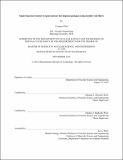| dc.contributor.advisor | Michael J. Driscoll and Thomas J. McKrell. | en_US |
| dc.contributor.author | Park, Yongsoo, S.M. Massachusetts Institute of Technology | en_US |
| dc.contributor.other | Massachusetts Institute of Technology. Department of Nuclear Science and Engineering. | en_US |
| dc.date.accessioned | 2017-03-10T15:05:11Z | |
| dc.date.available | 2017-03-10T15:05:11Z | |
| dc.date.copyright | 2016 | en_US |
| dc.date.issued | 2016 | en_US |
| dc.identifier.uri | http://hdl.handle.net/1721.1/107320 | |
| dc.description | Thesis: S.M., Massachusetts Institute of Technology, Department of Nuclear Science and Engineering, 2016. | en_US |
| dc.description | Cataloged from student-submitted PDF version of thesis. | en_US |
| dc.description | Includes bibliographical references (pages 71-75). | en_US |
| dc.description.abstract | Disposal packages containing high heat generating spent nuclear fuels (SNF) require improved heat transfer to keep the peak cladding temperature from going above the tolerance limit. Filling the accessible void spaces between the container and the SNF with a high heat conducting metal is a potential solution. In metal casting, it is well known that a gap forms at the metal-mold interface due to solidification shrinkage and it significantly reduces heat transfer during cooling. This negative heat transfer effect is persistent for a disposal package since the filler stays in the container after solidification. The key to close the gap is to promote metallic bonding by minimizing the oxidation of the container during the required preheating stage of the void filling process. However, direct contact between the container and the molten filler can lead to the growth of intermetallic phases, which can embrittle the container. The contribution of this work is twofold. First, through a down-scaled experiment, it was shown that coating a steel container with Zn and using Zn or Zn-4wt.%Al as a filler and unidirectionally cooling the melt from the bottom successfully suppressed the formation of the gap. Closing the gap increased the effective thermal conductivity of the package by a factor of roughly 6 under the employed experimental conditions. Second, tests showed that using near eutectic Zn-Al and executing the filling process at a temperature below the melting point of Zn suppressed the growth of any intermetallic phases. Specifically, this prevents the growth of Fe-Zn intermetallic phases due to the sufficiently high composition of Al, and it inhibits the dissolution and diffusion of Fe from the container by extending the presence of the ZnO diffusion barrier, which delays the growth of the Fe-Al intermetallic phases. | en_US |
| dc.description.statementofresponsibility | by Yongsoo Park. | en_US |
| dc.format.extent | 75 pages | en_US |
| dc.language.iso | eng | en_US |
| dc.publisher | Massachusetts Institute of Technology | en_US |
| dc.rights | MIT theses are protected by copyright. They may be viewed, downloaded, or printed from this source but further reproduction or distribution in any format is prohibited without written permission. | en_US |
| dc.rights.uri | http://dspace.mit.edu/handle/1721.1/7582 | en_US |
| dc.subject | Nuclear Science and Engineering. | en_US |
| dc.title | Improving heat transfer in spent nuclear fuel disposal packages using metallic void fillers | en_US |
| dc.title.alternative | Improving heat transfer in SNF disposal packages using metallic void fillers | en_US |
| dc.type | Thesis | en_US |
| dc.description.degree | S.M. | en_US |
| dc.contributor.department | Massachusetts Institute of Technology. Department of Nuclear Science and Engineering | |
| dc.identifier.oclc | 972828476 | en_US |
